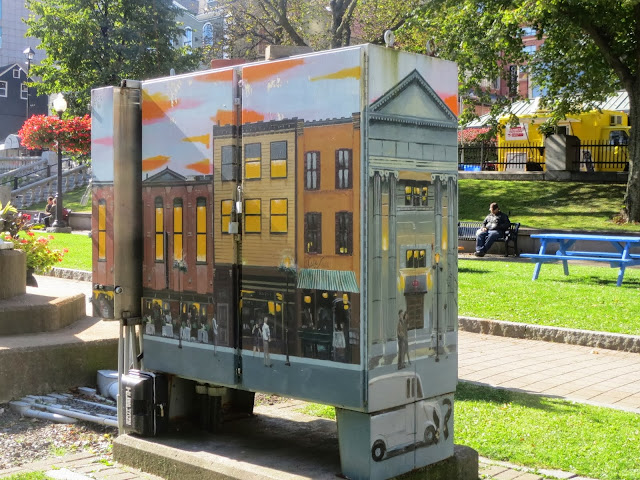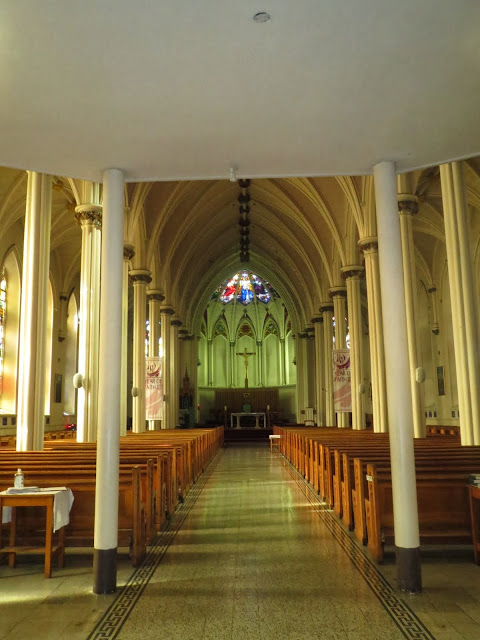Our final stop was Halifax. Halifax is the city believed to be the birth place of our great Grandfather, David Kenison. He was a sea captain; perhaps he sailed in and out of this Halifax port at some point.
Along the docks we came across these street lights. What do you suppose happened? Hurricane? Tornado? UFO landing? Nope- it's art. Entitled Got Drunk, Fell Down by Chris Hanson and Hendrika Sonnenberg, it features a fallen light pole, with a second light "seeming to look on with concern". According to the nearby sign, it "illustrates a biological need not frequently associated with keeping our streets illuminated after dark".
We visited the Maritime Museum of the Atlantic.
Here we learned that parrots are associated with pirates, not because most pirates had parrots, but because the pirates of Robert Louis Steven's Kidnapped did.
We examined some World War I mines,
as well as artifacts found in the sea
after one of the numerous area shipwrecks.
This is a deck chair from the Titanic. A number of ships were sent to find bodies 3 days after the initial disaster. Ships from Halifax pulled over 500 bodies from the water, some of which were eventually buried in Halifax.
This is a map indicating the wrecks in Nova Scotia since records have been kept. The large amount of shipwrecks are due to war, high traffic, weather, rocks, carelessness, as well as other reasons.
There were a number of very detailed ship models
which were fascinating to *not* me, but Stan wanted one for his office. Too bad none of the models would fit in our suitcase.
After the museum, we hoofed it over to the public gardens, a 16 acre Eden created in 1867 by combining two older private gardens.
It's a beautiful place,
and stunningly devoid of people.
The day was sunny and warm, a nice day to park-stroll.
From the gardens we headed to the citadel, the original 1749 fort.
After finding out it cost six month's of our income to go in and look around, we decided to just stare at the guard for awhile and move on.
I really like this painted utility box; so much nicer than government gray.
We spotted a church and headed over.
This is St. Paul's, an evangelical Anglican church.
It is the oldest (1750) building in Halifax and oldest surviving church Protestant church in Canada.
It was lovely inside,
with interesting stained glass scenes.
Like all Anglican churches we saw, we saw a mix of the spiritual, the governmental, and war memorials.
This was probably the most ornamental church we visited.
I love this depiction of the empty tomb.
The baby blue organ pipes were quite eye catching.
Beautiful sacrament table.
Like Saint John, Halifax had a disastrous historical incident. In 1917, two ships, one full of wartime explosives, collided in the harbor. The ensuing blast was the largest man-made explosion until the development of nuclear weapons. Two thousand people in Halifax were killed, 9000 injured, everything within 1/2 mile was completely obliterated, and buildings were heavily damaged for miles away. It even caused a tsunami which wiped out the indigenous people of Tuft's Cove, across the harbor from Halifax. This church has a piece of its window frame imbedded in an interior wall.
I had to laugh at this sore thumb of a solution:
the "Primary". I'm guessing they don't have as many children in attendance as our ward does.
We couldn't help noticing all of the renovation and construction going on. Seemingly every building was getting a facelift.
There was an enormous pit in the downtown area, a future skyscraper.
Our next stop was Province House, build in 1819.
It's the meeting place for the Nova Scotia Legislature.
I must say, our guide was lame, resorting to reading signs to tell us what we were looking at.
This is a beautiful three story building.
The woodwork is amazing.
Meeting room for the legislature.
An old row of telephone booths, now empty.
This place was as beautiful as the most expensive mansion.
We hang up Washington and Lincoln, they hang up English royalty.
A very appealing library.
The park next to the Province House.
Did you know Canada is phasing out the penny?
Oh look! Another church we should go see!
It's a young one-1899.
St. Mary's is a Catholic church, the first one we've seen in Canada.
I love the dome of the sanctuary.
A worker there told me Catholic churches usually have a font in the entrance, where infants are baptized. It's placed there to symbolize that all are welcome.
Close-up of the light over the font.
We took a quick look at Saint Matthew's United Church of Canada
with unusual corner organ pipes.
We stopped by a few churches that wouldn't let us in.
We passed La Fuji Mama's ugly stepsister, although we didn't visit her.
Halifax had lots of fun things to look at, including this side of a building, painted to look more interesting.
Our final stop of our trip before boarding the ship to return to New York was a touristy strip of stores, including this one. I almost passed it by, but since it was our last chance, we stop for some gelato.
To our surprise, it was the
BEST. GELATO. EVER!
I had black licorice and lemon. It was amazing, as tasty as the European version, the perfect end to our trip.
































































After seeing that map of shipwrecks, I'm not sure I would have gotten back on the cruise ship. I'm glad that you stopped for gelato rather than Fujiyama's food (obviously a wannabe).
ReplyDeleteGelato saves the day! It has been fun to see your posts. Particularly Halifax and St. John have been on my list. Now I feel as though I've been there. A cruise similar to this was one we looked at after Mom died (or maybe before Mom died), before finally settling on Germany. I think one day you just need to do a post on gelato, where in the world to get it.
ReplyDelete